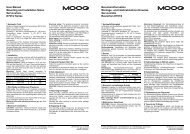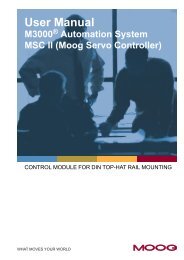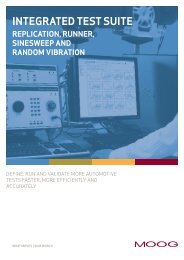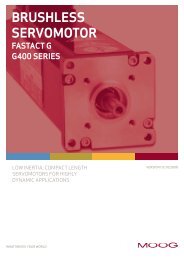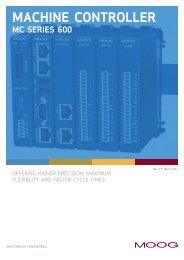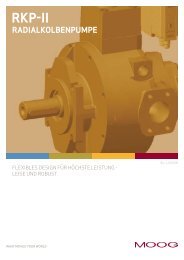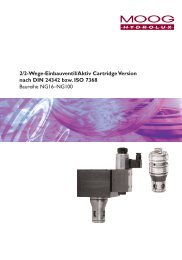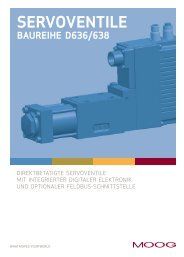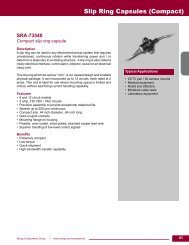You also want an ePaper? Increase the reach of your titles
YUMPU automatically turns print PDFs into web optimized ePapers that Google loves.
DESIGN AND INNOVATION<br />
Control<br />
under<br />
pressure<br />
What is a Moog valve and why has <strong>it</strong> become an essential part<br />
of Formula 1 technology over the last quarter of a century?<br />
BY CHARLES ARMSTRONG-WILSON<br />
W<strong>it</strong>h this E050 cartridge valve, Moog has taken <strong>it</strong>s valves from the rarified<br />
world of Formula 1 into the hostile environment of World Rallying<br />
Most people in<br />
motorsport have<br />
heard of Moog<br />
valves, but very<br />
few outside<br />
Formula 1 and World Rallying<br />
know much about what they are<br />
and what they do. We therefore<br />
set out to find out why they<br />
have become so essential at the<br />
top end of our sport.<br />
At their simplest, Moog<br />
valves are electrically operated<br />
servovalves that control hydraulic<br />
actuators. Their unique appeal,<br />
<strong>how</strong>ever, is the speed and<br />
accuracy w<strong>it</strong>h which they can<br />
regulate the flow using tiny<br />
electrical inputs. On a racecar<br />
this is an essential qual<strong>it</strong>y as<br />
a number of systems, such as<br />
gear selection and throttle<br />
operation, are driven by highpressure<br />
hydraulics, and fast,<br />
precise control is essential. The<br />
fundamental reason for the<br />
adoption of hydraulic technology<br />
in F1 is <strong>it</strong>s unparalleled ‘power<br />
dens<strong>it</strong>y’ and, in the weightconscious<br />
world of racecar<br />
engineering, hydraulic actuation<br />
systems are a fraction of the size<br />
and weight of the alternative<br />
electrical or pneumatic systems.<br />
The valves themselves were<br />
invented by Bill Moog in 1950,<br />
for use in aircraft and missiles,<br />
but <strong>it</strong> was not until the early<br />
1980s that they made their<br />
what is<br />
learned in<br />
F1 is rarely<br />
forgotten<br />
first appearance in motorsport.<br />
That was due to Team Lotus,<br />
which had been wrestling w<strong>it</strong>h<br />
the problems of ground-effect<br />
aerodynamics and the attendant<br />
ride height sens<strong>it</strong>iv<strong>it</strong>y. Its<br />
solution was active suspension<br />
– in essence, replacing the<br />
springs, dampers and anti-roll<br />
bars w<strong>it</strong>h hydraulic actuators<br />
controlled by a computer.<br />
To get the precision, the<br />
company turned to the aerospace<br />
industry and used off-theshelf<br />
Moog Series 30 hydraulic<br />
servovalves. By the early 1990s,<br />
while fully active suspension<br />
attracted few followers in F1,<br />
att<strong>it</strong>ude control by hydraulics had<br />
become the state of the art, w<strong>it</strong>h<br />
November 2008 • www.racecar-engineering.com 67
DESIGN AND INNOVATION<br />
HOW IT WORKS<br />
Valve responding<br />
to change in<br />
electrical input<br />
ÓWhen Bill Moog patented his fluid<br />
control valve in 1950, <strong>it</strong> comprised<br />
several hydraulic control principles<br />
developed over centuries. It was his<br />
packaging and refinement, <strong>how</strong>ever,<br />
that made the Moog fluid control valve<br />
such a powerful component. The clever<br />
part of a Moog valve is <strong>it</strong>s<br />
abil<strong>it</strong>y to precisely control the<br />
flow of high-pressure fluids<br />
w<strong>it</strong>h very small control inputs.<br />
The way <strong>it</strong> achieves this is by<br />
using the pressure of the fluid<br />
<strong>it</strong> controls to power the valve.<br />
A Moog valve continuously<br />
flows a small amount of fluid<br />
through two small jets facing each<br />
other. Between them is a flapper valve<br />
connected to the armature in a torque<br />
motor. The armature s<strong>it</strong>s between<br />
permanent magnets and, as a current<br />
is fed to wire coils around the armature,<br />
<strong>it</strong> twists a small amount – a couple of<br />
68 www.racecar-engineering.com • November 2008<br />
Moog’s product range for<br />
motorsport has grown to include<br />
<strong>it</strong>ems like this power-assisted<br />
steering valve<br />
When a current is applied the armature swings, blanking the flow from one jet and moving the spool. This, in turn, balances the force on the armature<br />
degrees at most. This, in turn, moves<br />
the flapper valve, obstructing the flow<br />
from one of the two jets and increasing<br />
the pressure in that feed compared w<strong>it</strong>h<br />
the other, which is still venting pressure<br />
through <strong>it</strong>s unrestricted jet.<br />
Both these pressure feeds are<br />
At some point, the two<br />
opposing forces reach an<br />
equilibrium that stabilises<br />
the pos<strong>it</strong>ion of the spool<br />
connected via a side gallery to e<strong>it</strong>her<br />
end of a sliding valve, called a spool, in<br />
a cylindrical gallery w<strong>it</strong>h cut-out valve<br />
orifices. The difference in pressure<br />
between the two feed pipes causes the<br />
spool to slide along the cylinder, opening<br />
a supply of the main pressure feed in the<br />
The company’s E024 series micro valve was developed specifically for<br />
motorsport and is now widely used on Formula 1 cars<br />
Valve cond<strong>it</strong>ion<br />
following charge<br />
direction required via the ports.<br />
The Moog valve has an add<strong>it</strong>ional<br />
refinement that gives <strong>it</strong> <strong>it</strong>s spectacular<br />
level of accuracy and control. On the end<br />
of the armature-mounted flapper valve<br />
is a feedback spring. Put simply, this is<br />
a flexible member w<strong>it</strong>h a ball end that<br />
locates in the spool. As the<br />
spool moves in response to the<br />
pressure difference, <strong>it</strong> moves<br />
the end of the feedback spring,<br />
opposing the movement of the<br />
flapper valve and armature. At<br />
some point, the two opposing<br />
forces reach an equilibrium<br />
that stabilises the pos<strong>it</strong>ion<br />
of the spool and, in turn, the amount<br />
of restriction to the main flow of fluid.<br />
In this way, <strong>it</strong> allows small changes to<br />
the current at the armature to produce<br />
precise changes to the flow of fluid. This<br />
principle allows the Moog valve to also<br />
work as a fluid pressure amplifier.
Although they differ in application, all Moog valves<br />
share the same basic principle of operation<br />
A linear actuator, as used to drive<br />
pos<strong>it</strong>ion-sens<strong>it</strong>ive systems like<br />
throttles and gear selector barrels<br />
most teams running some kind of<br />
short-stroke actuator under the<br />
springs. But for the 1994 season,<br />
the FIA chose to ban <strong>it</strong> for a<br />
number of reasons, including<br />
development cost and safety.<br />
F1 SYSTEMS<br />
What is learned in F1, <strong>how</strong>ever,<br />
is rarely forgotten and the Moog<br />
valve had, by then, found <strong>it</strong>s way<br />
into other areas of the car. As<br />
many as 10 systems on an F1 car<br />
were being controlled by Moog<br />
valves, including anti-lock braking,<br />
brake balance and braking<br />
power assistance. Moog had<br />
also recognised the sport as an<br />
ideal market for <strong>it</strong>s products and<br />
started making valves specifically<br />
to meet the demands of F1.<br />
Today, the most commonly<br />
used hydraulic servovalve in<br />
F1 is the Moog E024 series<br />
sub-miniature valve. Developed<br />
specifically for F1, <strong>it</strong> weighs just<br />
92g, less than half the weight<br />
of the company’s smallest<br />
aerospace valve. Typically, an<br />
F1 car would use five or six,<br />
operating the clutch, gearshift<br />
selector drums, throttle and<br />
differential.<br />
In the interests of minimum<br />
size and weight, F1 hydraulic<br />
systems run at very high<br />
pressures (up to 230bar) and an<br />
E024 servovalve can control as<br />
much as 5bhp (3.5KW) w<strong>it</strong>h a<br />
command signal of just +_10mA.<br />
This allows the valves to be<br />
driven directly from the car’s ECU.<br />
The valves are usually grouped<br />
onto a single hydraulics block,<br />
through which hydraulic pressure<br />
is distributed and controlled.<br />
Essentially, all the valve<br />
does is accurately control the<br />
flow of hydraulic fluid and, to<br />
make this property useful in a<br />
racecar, <strong>it</strong> has to be incorporated<br />
into a feedback loop w<strong>it</strong>h a<br />
sensor. On the throttles and the<br />
gear selection barrels, where<br />
precise pos<strong>it</strong>ion is key,<br />
the valve operates<br />
in response to a<br />
pos<strong>it</strong>ion sensor. On the<br />
differential, <strong>how</strong>ever,<br />
<strong>it</strong> is responding to the<br />
signal from a pressure<br />
sensor. The clutch can<br />
be e<strong>it</strong>her, depending<br />
on the control strategy<br />
chosen. In these applications,<br />
very fast response is essential,<br />
the E024 for example reacting to<br />
an input in less than 1ms.<br />
Two other applications for<br />
the Moog valve on an F1 car are<br />
the fuel flap and reverse gear.<br />
Both are simple on-off scenarios<br />
and do not use the closed-loop<br />
technology normally associated<br />
w<strong>it</strong>h Moog valves. A feature of<br />
the E024 valve, <strong>how</strong>ever, is that<br />
<strong>it</strong> can be modified to mimic the<br />
function of two independent,<br />
three-way solenoid valves,<br />
meaning a single E024 valve can<br />
A spool from one of<br />
Moog’s linear powerassisted<br />
steering valves<br />
be used e<strong>it</strong>her to open the fuel<br />
flap or to select reverse gear,<br />
saving the weight of a second<br />
valve and <strong>it</strong>s associated wiring<br />
and mounting manifold. This<br />
relies on the premise that <strong>it</strong>’s<br />
not necessary to re-fuel while<br />
travelling in reverse!<br />
Over the years, the demands<br />
placed on Moog’s products by F1<br />
have intensified and there has<br />
been constant development to<br />
rise to the challenge. Response<br />
times, in particular, are cr<strong>it</strong>ical<br />
to make this useful<br />
in a racecar <strong>it</strong> has to<br />
be incorporated into<br />
a feedback loop w<strong>it</strong>h a<br />
sensor<br />
and considerable effort has been<br />
put into reducing the inertia of<br />
the armature in the torque motor,<br />
increasing <strong>it</strong>s field strength and<br />
reducing the air gaps. This has<br />
enabled Moog to reduce the<br />
response time of the electrics to<br />
less than 1ms, helping the valve<br />
achieve maximum control flow in<br />
less than 3ms.<br />
Temperature also places great<br />
demands on hydraulic systems<br />
and their control valves. On an<br />
F1 car, the hydraulic fluid will<br />
typically operate at around<br />
100-135degC and the high<br />
pressure and throttling action of<br />
the valve generates more heat.<br />
The hydraulic fluid reservoir of<br />
an F1 car typically holds less<br />
than 300cc, so there is very<br />
l<strong>it</strong>tle mass of fluid to absorb<br />
heat and temperatures can<br />
rise very quickly. There is also<br />
reluctance on the part of teams<br />
to provide oil-to-air coolers for<br />
the fluid due to the extra weight<br />
and aerodynamic drag incurred.<br />
Instead, they sometimes use oilto-water<br />
heat exchangers w<strong>it</strong>h<br />
the engine coolant<br />
that will already be<br />
running in excess of<br />
110degC.<br />
All this means the<br />
valves have to be<br />
designed to cope w<strong>it</strong>h<br />
the heat. All seals<br />
are of V<strong>it</strong>on hightemperature<br />
material<br />
and machining tolerances are<br />
kept very tight in pursu<strong>it</strong> of good<br />
sealing. At the high temperatures<br />
to which F1 subjects <strong>it</strong>s hydraulic<br />
fluids, viscos<strong>it</strong>y is considerably<br />
reduced, down to as low as<br />
4-5CSt, compared w<strong>it</strong>h 20CSt in<br />
normal industrial applications.<br />
Such low viscos<strong>it</strong>y makes<br />
retaining the fluid a challenge<br />
and the clearance between the<br />
spool and the valve housing<br />
needs to be just 1.25m.<br />
Such precision components<br />
being used in a hostile<br />
environment inev<strong>it</strong>ably have<br />
November 2008 • www.racecar-engineering.com 69 69
Mick Hill at freelanceillustration.com<br />
DESIGN AND INNOVATION<br />
FORMULA 1 APPLICATIONS<br />
a lim<strong>it</strong>ed service life and in F1<br />
Moog valves are usually replaced<br />
after 12,000km. They also need<br />
to be serviced e<strong>it</strong>her every<br />
4000km, or after 20<br />
hours of use. This<br />
entails the valve<br />
being dismantled<br />
and inspected and<br />
key parts replaced,<br />
including the seals,<br />
a tiny, 15m filter<br />
that strains out<br />
particles and a thin-wall stainless<br />
steel tube in the pilot stage.<br />
For a long time, rallying<br />
resisted the use of Moog<br />
valves due to their need for<br />
scrupulously clean hydraulic fluid<br />
70 www.racecar-engineering.com • November 2008<br />
70<br />
FRONT WING<br />
ACTUATION<br />
POWER-ASSISTED<br />
BRAKING<br />
ACTIVE<br />
SUSPENSION<br />
ENGINE INLET<br />
TRUMPETS<br />
CLUTCH CONTROL<br />
Diagrammatic s<strong>how</strong>ing the multiple and varied roles of Moog control valves on the current breed of Formula 1 cars<br />
being perceived as incompatible<br />
w<strong>it</strong>h the nature of servicing<br />
on events. Ever more complex<br />
transmissions w<strong>it</strong>h active<br />
differentials requiring precise<br />
hydraulic control, <strong>how</strong>ever,<br />
forced the manufacturers to<br />
consider Moog valves. The<br />
company responded w<strong>it</strong>h <strong>it</strong>s<br />
E050 Proportional Cartridge DDV,<br />
THROTTLE<br />
ACTUATION<br />
POWER-ASSISTED<br />
STEERING<br />
ABS<br />
BRAKING<br />
BRAKE BALANCE<br />
the valve is much<br />
less susceptible to fluid<br />
contamination and the<br />
hydraulic system can be<br />
serviced in the field<br />
GEARBOX<br />
ACTUATION<br />
KERS<br />
TRANS-<br />
MISSION<br />
which uses a linear electric motor<br />
to activate the spool valve. By<br />
removing the pilot stage and <strong>it</strong>s<br />
very fine jets, the valve is much<br />
less susceptible to<br />
fluid contamination<br />
and the hydraulic<br />
system can be<br />
serviced in the field.<br />
Desp<strong>it</strong>e<br />
approaching <strong>it</strong>s 60th<br />
birthday then, the<br />
Moog valve is still<br />
very much part of the cuttingedge<br />
technology on which<br />
motorsport’s highest echelons<br />
rely and, unless hydraulics fall<br />
from favour, looks likely to<br />
remain so.<br />
Ó Over<br />
POWER<br />
STEERING<br />
the years,<br />
Formula 1 steering<br />
has become increasingly<br />
heavy, as steering<br />
geometry has sought<br />
to extract aerodynamic<br />
benef<strong>it</strong>s. Now all<br />
F1 cars have power<br />
steering and would be<br />
undriveable w<strong>it</strong>hout. A<br />
few years ago, <strong>how</strong>ever,<br />
during one of <strong>it</strong>s<br />
sweeping rule changes<br />
aimed at attempting to<br />
put control of the cars<br />
back in the hands of the<br />
drivers, the FIA banned<br />
electromechanical<br />
power steering. This<br />
removed any abil<strong>it</strong>y<br />
to map the steering<br />
assistance the driver<br />
was given in response<br />
to the cond<strong>it</strong>ions. Some<br />
form of power steering<br />
was still needed,<br />
<strong>how</strong>ever, and because<br />
Moog valves had been<br />
used in the now banned<br />
electromechanical<br />
systems, <strong>it</strong> was an<br />
obvious move for the<br />
company to look at<br />
developing a passive,<br />
hydro-mechanical,<br />
power-assisted<br />
steering system.<br />
HYDRO-MECHANICAL<br />
What the company<br />
came up w<strong>it</strong>h is in<br />
essence very similar<br />
to the principles of a<br />
conventional road car<br />
system, but smaller,<br />
lighter, more accurate<br />
and able to work at<br />
constant pressures of<br />
200Bar. Essentially,<br />
the regulating valve<br />
is very similar to one<br />
of the company’s<br />
electro-hydraulic servo<br />
valves but, instead<br />
of the signal coming<br />
from a torque motor,<br />
<strong>it</strong> is fed from a torsion<br />
bar or linear springs<br />
in the load path of the<br />
steering. As the steering<br />
load increases <strong>it</strong> creates<br />
a displacement in<br />
the torsion bar that is<br />
linked directly to the<br />
spool that, just as in the<br />
normal valve, provides a<br />
pressure differential<br />
to the ends of the<br />
steering rack, giving<br />
power assistance.





